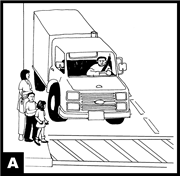TIP #9: BEYOND THE FRONT YARD: CREATING SAFER STREETS AND PLAY PLACES FOR CHILDREN
 |
Crawling... walking... bike riding... in-line and roller skating. As babies grow into school kids they move farther and faster. They love to be on the move-- to the neighbor's house, the school yard, the park or the store! These activities are great for your children, if your neighborhood has safe playgrounds, sidewalks, and parks.
Young children need safe places for active play. They need safe ways
to get themselves to school, sports events, and other points of interest.
Yet, many communities today are not kid-friendly for walking and biking.
HOW SAFE ARE YOUR NEIGHBORHOOD STREETS AND RECREATION SITES?
Pedestrian-friendly neighborhood streets include:
- Places to walk off the street (sidewalks, wide shoulders).
- Sidewalks
and wide shoulders that make walking easy (no overgrown bushes, dangerous
ditches, trash bins, or parked cars in the way).
- Places to cross
the streets easily and safely (crosswalks, traffic signals).
- Crossing
Guards near schools to help children cross.
- Courteous drivers that
obey the speed limits and stop for pedestrians.
- Safe play areas for
children.
Safe places for children to play outdoors include:
- Areas that are fenced-in or away from busy streets
and traffic.
- Playgrounds where equipment is in good
shape.
- Play areas with soft surfaces (wood chips, rubber,
sand) below swings and climbing structures.
- Grassy areas for games.
- Paths for bicycling.
YOU CAN MAKE A DIFFERENCE!
There are things you can do to create safer streets and play areas for children.
Things that you can do yourself:
 |
- As a driver, set an example by stopping and giving
pedestrians the right of way (A).
- Share the road safely with bicyclists.
- Obey speed limits, especially
in neighborhoods where children play. Be extra careful in school
zones.
Things you can do with others:
- Do a safety audit of your neighborhood using
the "Walkability
Checklist" or "Bikeability Checklist" (see below).
- Share
the results with others in your community who are concerned with
child safety: neighbors, police officers, traffic engineers, school
transportation directors, parent-teacher associations, and other community
groups.
- Write letters to your newspaper and speak up at public
meetings.
- Work with your city or county traffic safety engineer
to identify ways to make the streets safer.
- Encourage construction of playgrounds near homes, if needed, so children don't have to play in streets and parking areas.
To get the Walkability or Bikeability Checklist (check for availability in Spanish) or for more information, visit www.nhtsa.dot.gov
 |
For more information, contact the DOT Auto Safety Hotline at 1-888-DASH-2-DOT (1-888-327-4236) or www.nhtsa.dot.gov Illustrations from Indiana University School of Medicine |
next |